Install LEMP Stack (Nginx, MariaDB, PHP7.2) on RHEL 8/CentOS 8
This tutorial is going to show you how to install LEMP stack on RHEL 8 and CentOS 8.
What’s LEMP Stack?
A software stack is a set of software tools bundled together. LEMP stands for Linux, Nginx (pronounced engine X), MariaDB/MySQL and PHP, all of which are open source. It is the most common software stack that powers dynamic websites and web applications. Linux is the operating system; Nginx is the web server; MariaDB/MySQL is the database server and PHP is the server-side scripting language responsible for generating dynamic web pages.
Prerequisites
You can download and install RHEL 8 by following the tutorial below.
If you are looking for a VPS (Virtual Private Server), then you can register an account at Vultr via my referral link to get $50 free credit for use over 30 days.
This tutorial uses root account to manage administration tasks. To switch to root, run the following command and enter root password.
su -
Step 1: Install Nginx Web Server on RHEL 8/CentOS 8
Nginx is a high performance web server and very popular these days. It also can be used as a reverse proxy and caching server. Enter this command to install Nginx Web server.
yum install nginx -y
After it’s installed, we can start Nginx with this command:
systemctl start nginx
Enable Nginx to auto start at system boot time by running the following command.
systemctl enable nginx
Now check its status.
systemctl status nginx
Output:
● nginx.service - The nginx HTTP and reverse proxy server Loaded: loaded (/usr/lib/systemd/system/nginx.service; enabled; vendor preset: disabled) Active: active (running) since Wed 2018-12-05 02:04:00 EST; 7s ago Main PID: 5032 (nginx) Tasks: 2 (limit: 11512) Memory: 8.4M CGroup: /system.slice/nginx.service ├─5032 nginx: master process /usr/sbin/nginx └─5034 nginx: worker process
“Enabled” indicates that auto start at boot time is enabled and we can see that Nginx is running. Notice that the above command will not immediately quit after running. You need to press “q” to make it quit.
Check Nginx version.
nginx -v
Output:
nginx version: nginx/1.14.1
If you are installing LEMP on your local RHEL 8/CentOS 8 computer, then type 127.0.0.1 or localhost in the browser address bar. You should see the “Welcome to Nginx” Web page, which means Nginx Web server is running properly.
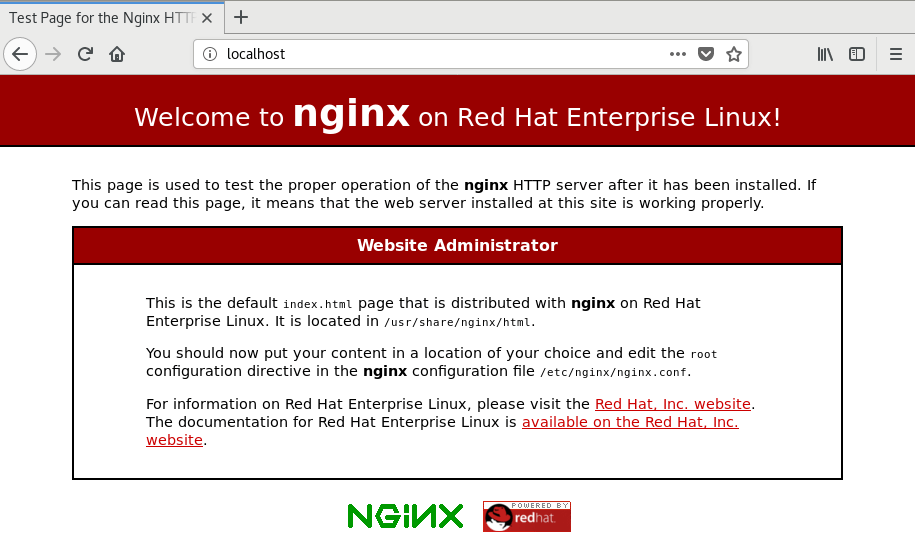
By default, RHEL 8/CentOS 8 forbids public access to port 80. To allow other computers to access the web page, we need to open port 80 in firewalld, the dynamic firewall manager on RHEL/CentOS. Run the following command to open port 80.
firewall-cmd --permanent --zone=public --add-service=http
If you want to enable HTTPS on Nginx later, then you also need to open port 443.
firewall-cmd --permanent --zone=public --add-service=https
The --permanent option will make this firewall rule persistent across system reboots. Next, reload the firewall daemon for the change to take effect.
systemctl reload firewalld
Now the Nginx web page is accessible publicly.
Finally, we need to make user nginx as the owner of web directory. By default it’s owned by the root user.
chown nginx:nginx /usr/share/nginx/html -R
Step 2: Install MariaDB Database Server on RHEL 8/CentOS 8
MariaDB is a drop-in replacement for MySQL. It is developed by former members of MySQL team who are concerned that Oracle might turn MySQL into a closed-source product. Enter the following command to install MariaDB on RHEL 8/CentOS 8.
yum install mariadb-server mariadb -y
After it’s installed, we need to start it.
systemctl start mariadb
Enable auto start at system boot time.
systemctl enable mariadb
Check status:
systemctl status mariadb
output:
● mariadb.service - MariaDB 10.3 database server Loaded: loaded (/usr/lib/systemd/system/mariadb.service; enabled; vendor preset: disable> Active: active (running) since Wed 2018-12-05 02:40:44 EST; 8s ago Docs: man:mysqld(8) https://mariadb.com/kb/en/library/systemd/ Main PID: 17582 (mysqld) Status: "Taking your SQL requests now..." Tasks: 30 (limit: 11512) Memory: 75.2M CGroup: /system.slice/mariadb.service └─17582 /usr/libexec/mysqld --basedir=/usr
“Enabled” indicates that auto start at boot time is enabled and we can see that MariaDB server is running. Now we need to run the security script.
mysql_secure_installation
When it asks you to enter MariaDB root password, press Enter key as the root password isn’t set yet. Then enter y to set the root password for MariaDB server.
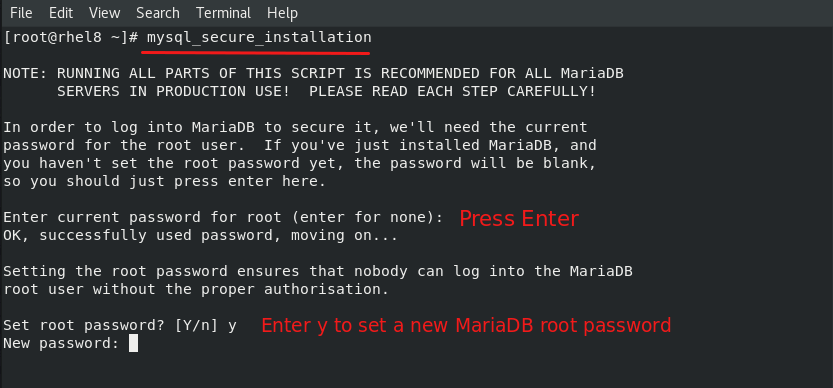
Next, you can press Enter to answer all remaining questions, which will remove anonymous user, disable remote root login and remove test database. This step is a basic requirement for MariaDB database security. (Note that the letter Y is capitalized, which means it’s the default answer.)
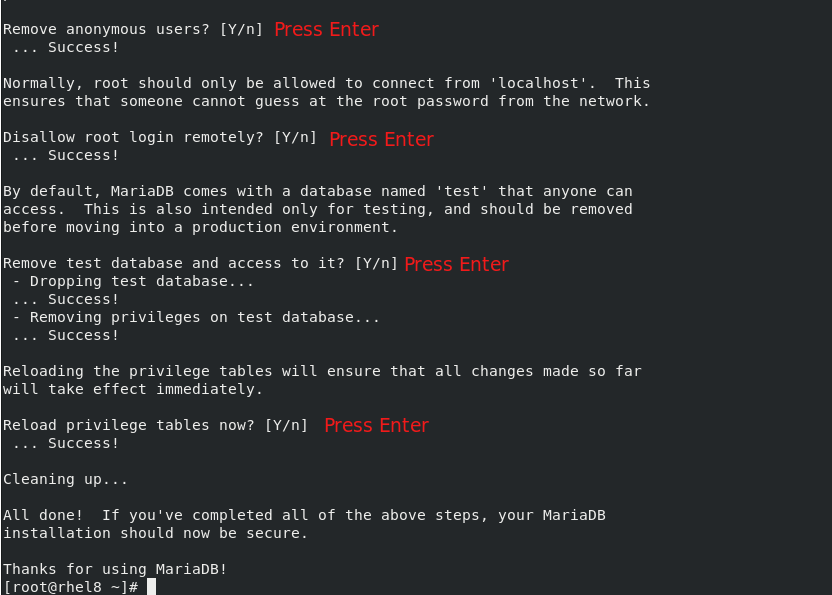
Now you can run the following command and enter MariaDB root password to log into MariaDB shell.
mysql -u root -p
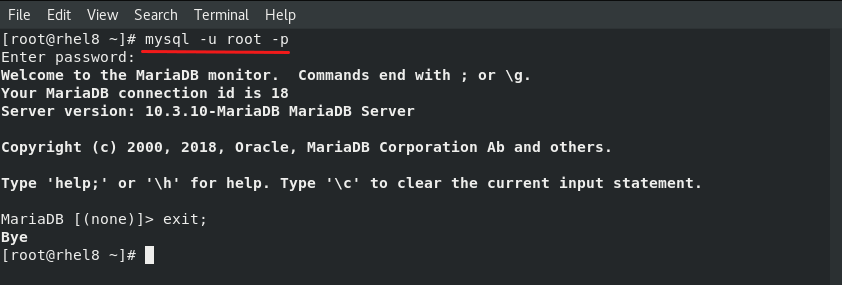
To exit, run
exit;
Step 3: Install PHP-FPM on RHEL 8/CentOS 8
Install PHP and related modules using the following command:
yum install php php-mysqlnd php-fpm php-opcache php-gd php-xml php-mbstring -y
After it’s installed, we need to start it.
systemctl start php-fpm
Enable auto start at system boot time.
systemctl enable php-fpm
Check status:
systemctl status php-fpm
output:
● php-fpm.service - The PHP FastCGI Process Manager Loaded: loaded (/usr/lib/systemd/system/php-fpm.service; enabled; vendor preset: disable> Active: active (running) since Wed 2018-12-05 03:06:01 EST; 22s ago Main PID: 18631 (php-fpm) Status: "Processes active: 0, idle: 5, Requests: 0, slow: 0, Traffic: 0req/sec" Tasks: 6 (limit: 11512) Memory: 29.6M CGroup: /system.slice/php-fpm.service ├─18631 php-fpm: master process (/etc/php-fpm.conf) ├─18632 php-fpm: pool www
“Enabled” indicates that auto start at boot time is enabled and we can see that PHP-FPM is running. Now edit the PHP-FPM config file:
nano /etc/php-fpm.d/www.conf
By default, PHP-FPM runs as the apache user. Since we are using Nginx web server, we need to change it. Find the following two lines.
user = apache group = apache
Change them to
user = nginx group = nginx
In this file you can find the following line.
listen = /run/php-fpm/www.sock
This indicates that PHP-FPM is listening on a Unix socket instead of a TCP/IP socket, which is good. Save and close the file. Reload PHP-FPM for the changes to take effect.
systemctl reload php-fpm
Step 4: Test PHP
By default, the Nginx package on RHEL 8/CentOS 8 includes configurations for PHP-FPM (/etc/nginx/conf.d/php-fpm.conf and /etc/nginx/default.d/php.conf). To test PHP-FPM with Nginx Web server, we need to create a info.php file in the document root directory.
nano /usr/share/nginx/html/info.php
Paste the following PHP code into the file.
<?php phpinfo(); ?>
Save and close the file. If you installed LEMP stack on a local RHEL 8/CentOS 8 server, type in 127.0.0.1/info.php or localhost/info.php in the browser address bar. You should see your server’s PHP information. This means PHP scripts can run properly with Nginx web server.
If RHEL 8/CentOS is running on a remote server, then enter server-ip-address/info.php in browser address bar. Replace sever-ip-address with your actual IP address.
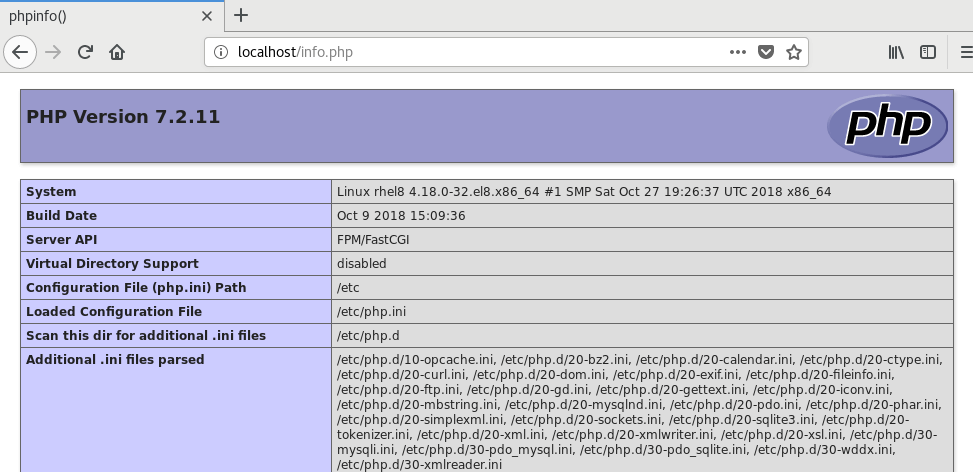
If the browser fails to display the PHP info but prompt you to download the info.php file, simply restart Nginx and PHP-FPM.
sudo systemctl restart nginx php-fpm
Then you should be able to see the PHP info in the web browser.
Nginx Automatic Restart
If for any reason your Nginx process is killed, you need to run the following command to restart it.
sudo systemctl restart nginx
Instead of manually typing this command, we can make Nginx automatically restart by editing the nginx.service systemd service unit. To override the default systemd service configuration, we create a separate directory.
sudo mkdir -p /etc/systemd/system/nginx.service.d/
Then create a file under this directory.
sudo nano /etc/systemd/system/nginx.service.d/restart.conf
Add the following lines in the file, which will make Nginx automatically restart 5 seconds after a failure is detected.
[Service] Restart=always RestartSec=5s
Save and close the file. Then reload systemd.
sudo systemctl daemon-reload
To check if this would work, kill Nginx with:
sudo pkill nginx
Then check Nginx status. You will find Nginx automatically restarted.
systemctl status nginx
Wrapping Up
Congrats! You have successfully installed Nginx, MariaDB and PHP7.2 on Red Hat 8 or CentOS 8. For your server’s security, you should delete info.php file now to prevent hacker seeing it.
rm /usr/share/nginx/html/info.php
I hope this tutorial helped you. As always, if you found this post useful, then subscribe to our free newsletter to get more tips and tricks. Take care 🙂



Thanks.
When I do this, the localhost/info.hp address just downloads a txt file named info.php.
Everything up to this point worked perfectly. I believe that the server is not actually executing the .php code. Do you have any ideas on how to fix this?
Thanks
If the browser fails to display the PHP info but prompt you to download the info.php file, simply restart Nginx and PHP-FPM.
Then you should be able to see the PHP info.
Add this section to your nginx.conf to execute php files:
location ~ \.php$ { try_files $uri =404; include fastcgi_params; fastcgi_pass 127.0.0.1:9000; fastcgi_connect_timeout 10s; fastcgi_read_timeout 300s; fastcgi_param HTTP_PROXY ""; fastcgi_index index.php; fastcgi_param PATH_INFO $fastcgi_script_name; fastcgi_param SCRIPT_FILENAME $document_root$fastcgi_script_name; }Then reload nginx:
PHP-FPM by default listens on the /run/php-fpm/www.sock Unix socket, instead of the 127.0.0.1:9000 TCP socket.
If the browser fails to display the PHP info but prompt you to download the info.php file, simply restart Nginx and PHP-FPM.
Then you should be able to see the PHP info in the web browser.
Following these instructions first I had issues with SELinux not letting me restart php-fpm, then I followed the instructions in the warning and it still fails to start php-fpm:
failed to write the ACL of the socket ‘/run/php-fpm/www.sock’: Invalid argument
I think you need to run the following command:
After correcting the way I was changing the user and group from apache to nginx it just works. Don’t have to do any SELinux stuff.
Thanks for the article. I’m trying to make it easier to install Nextcloud on CentOS 8 and this is the first step. Using your article as a guide I’ve created an Ansible playbook that will get LEMP running on a CentOS 8 server. https://github.com/FlexibleToast/CentOS-8-LEMP. I’m still working on the Nextcloud playbook that will also include LEMP installation.
After this guide. I can not connect my Open VPN server from public ip. Also The php file not showing. Just download section. This guide need to update.
This guide is accurate and certainly won’t interfere with OpenVPN.
It was my mistake I think. But still php not working. When I try to go info.php, it show me download section.
Your guide was terrific, thank you so much! Just one question for you though..
If I’m syncing a folder via the desktop app that has a bunch of large files, everything works fine. However, if I try to sync a folder with thousands of small files I start to get Serialization failure: 1213 Deadlock found when trying to get lock; try restarting transaction
I’ve googled around and found people suggest:
Add the following three lines in [mysqld] section.
log-bin = /var/log/mysql/mariadb-bin
log-bin-index = /var/log/mysql/mariadb-bin.index
binlog_format = mixed
But that has not fixed it. Are you aware of any database tweaking that would help? Do you have an example of your my.cnf that might help lead me in the right direction?
You are asking a question unrelated to this article. I don’t know what is the desktop app you are referring to.
The nextcloud desktop app. Either way, related in that I’m just asking if you did any customizations in your my.cnf
I don’t have customization in my.cnf. This error is usually caused by the web app code. You should report this error to Nextcloud developers.
Thanks! Got me up and running on my first linode in 10 minutes 🙂
great guide, thanks!
The first tutorial that I successfully can install LEMP. Thank youuuu.
Just FYI, for step four I had to chown the info.php file to nginx:nginx (it was root:root) for it to work. Otherwise, web browsers just downloaded the info.php file rather than displaying it in the browser.
I am facing the localhost/info.hp address just downloads a txt file named info.php.
But centos 8 update , Problem is solve.
Thanks..
Hello! First of all, thank you for writing such a wonderful tutorial.
I’m having a similar problem as mentioned by others regarding https://domain/info.php being downloaded instead of executed in browser.
I have been following along with your tutorial, setting up an email server in centOS.
I have double checked everything and I still can’t find where the problem might be.
VPS: vultr
OS:
NAME="CentOS Linux" VERSION="8 (Core)" ID="centos" ID_LIKE="rhel fedora" VERSION_ID="8" PLATFORM_ID="platform:el8" PRETTY_NAME="CentOS Linux 8 (Core)" ANSI_COLOR="0;31" CPE_NAME="cpe:/o:centos:centos:8" HOME_URL="https://www.centos.org/" BUG_REPORT_URL="https://bugs.centos.org/" CENTOS_MANTISBT_PROJECT="CentOS-8" CENTOS_MANTISBT_PROJECT_VERSION="8" REDHAT_SUPPORT_PRODUCT="centos" REDHAT_SUPPORT_PRODUCT_VERSION="8"nginx -v:
nginx version: nginx/1.14.1When I visit https://my-domain I see the Welcome to nginx page.
firewall-cmd –list-services
systemctl status php-fpm: Active and running, no errors. Not sure if this is important but CGroup: /system.slice/php-fpm.servic is:
├─3395 php-fpm: master process (/etc/php-fpm.conf) ├─3406 php-fpm: pool www ├─3407 php-fpm: pool www ├─3408 php-fpm: pool www ├─3409 php-fpm: pool www └─3410 php-fpm: pool wwwOwnership of /usr/share/nginx/html is nginx:nginx:
Step 2: Install MariaDB
I installed it as outlined in the tutorial
Step 3: Install PHP-FPM on CentOS 8
All php and related modules installed:
systemctl shows php-fpm.service to be active and enabled, no erros. The PHP FastCGI Process Manager is running.
The /etc/php-fpm.d/www.conf user & group edit:
; Unix user/group of processes ; Note: The user is mandatory. If the group is not set, the default user's group ; will be used. ; RPM: apache user chosen to provide access to the same directories as httpd user = nginx ; RPM: Keep a group allowed to write in log dir. group = nginxAlso,
is uncomented just as it should be. I didn’t touch it.
I created the info.php file and added
to it.
# ls -l total 28 -rw-r--r--. 1 nginx nginx 3971 Oct 7 2019 404.html -rw-r--r--. 1 nginx nginx 4020 Oct 7 2019 50x.html -rw-r--r--. 1 nginx nginx 4057 Oct 7 2019 index.html -rw-r--r--. 1 nginx nginx 20 Oct 5 13:23 info.php -rw-r--r--. 1 nginx nginx 368 Oct 7 2019 nginx-logo.png -rw-r--r--. 1 nginx nginx 4148 Oct 7 2019 poweredby.pngI changed the user:group from root:root to nginx:nginx. Even when I leave it as root:root it does not work.
I restart nginx and php-fpm without a problem. The status for both service is error free.
I vist https://my-domain/info.php and it wants to download the info.php file instead of showing it in browser.
I visited the info.php page on my phone, same results.
I visited the info.php page on firefox (the first time I visit it so not in cache), same result.
I don’t know what is wrong…
Just wanted to clarify a details that got clipped out when I posted.
I added the php code:
I entered it like the tutorial has it, when I post it here it clipped out for some reason so I’m posting it here without the tags.
it does not work and downloads info.php because probably if you followed these manuals, default website configuration in /etc/nginx/conf.d is made by certbot and it is missing php location.
See my comment below
Add:
location = favicon.ico { access_log off; log_not_found off; } index index.php; location / { try_files $uri $uri/ =404; } location ~ \.php$ { fastcgi_pass php-fpm; fastcgi_param SCRIPT_FILENAME $document_root$fastcgi_script_name; include fastcgi_params; }it does not work and downloads info.php because probably if you followed these manuals, default website configuration in /etc/nginx/conf.d is made by certbot and it is missing php location.
So all you have to do is add:
server { server_name domain-name.com; root /usr/share/nginx/html/; location ~ /.well-known/acme-challenge { allow all; } location = favicon.ico { access_log off; log_not_found off; } index index.php; location / { try_files $uri $uri/ =404; } location ~ \.php$ { fastcgi_pass php-fpm; fastcgi_param SCRIPT_FILENAME $document_root$fastcgi_script_name; include fastcgi_params; }thanks, work like a charm
Everyone, please be remind that comment upstream web and proxy_pass, add location ~ .php$